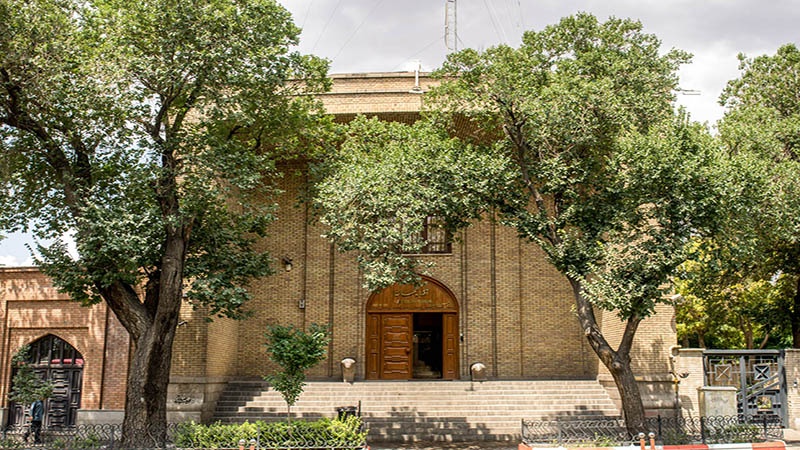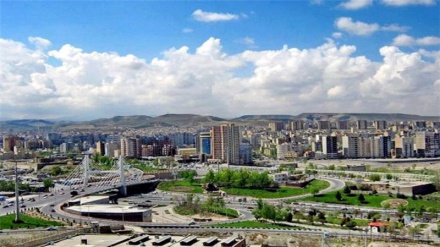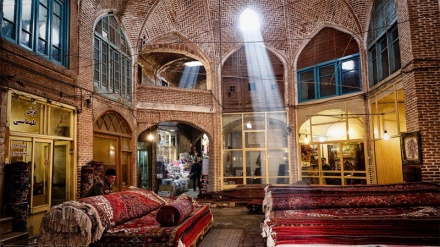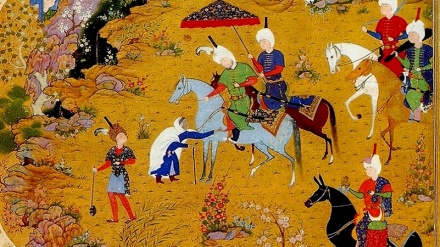Tabriz, 2018 (13)
Welcome to this week's episode of the series "Tabriz, 2018". Today, we become familiar with some of the historical monuments of the city of Tabriz, including this city's marketplace, Shahrdari Edifice, and Azarbaijan Museum.
Azarbaijan Museum is one of the most valuable museums of Iran, ranking second among museums of archeology across the country.
Visitors to this museum can closely observe historical works belonging to pre- and post-Islamic eras. Hence, this museum is a popular venue for enthusiasts in Iran's history.
Azarbaijan Museum was officially launched in the year 1962. This museum consists of three halls, covering an area of 800 square meters, within which highly valuable historical items of Iran are on display all year long. On the ground floor of this museum, historical items and objects, belonging to pre-historic, and pre-Islamic times are on display; some of which date back to 7,000 years ago. The mineral stones, which have been discovered in the city of Jiroft, date back to pre-historic times; on some of which drawings of different plants and animals are evident.
On the 1st floor of this museum, unique items are on display for the visitors; the most ancient of which dates back to 4th Century AH, and belongs to the city of Nayshapour. Some of the most important features of these items are the usage of Kufi alphabet, Arabesque patterns, and white enamel in them.
Within the hall of historical coins and rubberstamps of Iran, the oldest minted coins of Iran, from the Archamenian era to Qajarid era are shown, while samples of Iran's historical rubberstamps also decorate this section of the museum.
At the basement of this museum, visitors are witness to hand-made metallic works and statues, which have been created by the Tabrizi artist, Ahad Husseini.
The historical petroglyphs section of the museum is the newest department of this venue; which displays a number of human statues, gravestones, inscriptions, stone-made rams, and stone-made statues.
Azarbaijan Museum is situated next to Kaboud Mosque, and in the vicinity of Tabriz Shahrdari Edifice.
In the vicinity of this museum, the Shahrdari Edifice is situated, which is registered among Iran's national works.
This edifice has been constructed in the year 1939 at a plot of land, covering an area of 9,600 square meters, with a foundation of 6,500 square meters. It is a three-story building, consisting of 80 rooms and 10 halls, capturing the attention of all viewers. The clock tower of this edifice has led to the popularity of this building.
This building is U-shaped and is made of stone. It maintains several gates and engraved stones. This building is the first municipality of Iran.
Shahrdari Edifice maintains an exceptional architectural style. A clock has been installed at the top of this building.
Currently, upon changing the this building into a museum, a large number of historical treasures are on display throughout its halls.
A variety of hand-written books and documents, valuable, ancient carpets, and old cameras are at display in this museum.
At the basement of this building, there are shoes, lanterns, and fire station museums. The Martyrs Museum is located at the 1st floor of this museum, which displays the memoirs, photos, and hand-writings of the martyrs of the city of Tabriz. The carpet museum is situated at the 2nd floor of this building, showcasing carpets, most of which date back to roughly 80 years ago.
Tabriz marketplace covers an area of roughly one square kilometers, and is known as the largest brick-made roofed marketplace across the world. It is one of the tourist attraction sites of this city and is considered as one of the pillars of the grandeur and importance of Tabriz. This historical marketplace is in downtown, leading to the palaces of Qajarid crown princes from the east, and Jam'eh Mosque from the west. This marketplace was enlisted among Iran's national works in the year 1975, and among UNESCO global heritages in the year 2010. Given the location of Tabriz en route Silk Road, this city's marketplace has been burgeoning as of ancient times, and highly contributed to growth of trade and economy in this city. Currently, despite the establishment of several modern commercial centers in this city, Tabriz marketplace remains the lifeline of trade in this city.
The precise date of construction of this marketplace is unknown. However, based on a number of existing documents, this marketplace existed as of 4th Century AH in the city of Tabriz. Many of the tourists, who have visited this marketplace as of 4th Century AH to Qajarid era, have rendered data on this venue, such as Marco Polo, and Jean Chardin, whose writings have praised the glory and grandeur of this marketplace.
Tabriz marketplace was reconstructed nearly 300 years ago, after an earthquake rocked this city. There are 5,500 stalls in this marketplace. This market is a three-story building. The basement is for storing goods. The second floor is the trade house, and the third floor is used for resting.
Tabriz marketplace, in addition to the diversity of its goods, maintains a beautiful and unique architecture. The Mozzafarieh Arcade is one of the most important sections of this marketplace, and is the venue for purchase and sales of Tabriz carpets. In other words, this arcade is the main source of Iranian carpets. It is built in two floors; with 26 stalls on each floor. At the ground floor of this arcade, there are the stalls of carpet sellers; and the shops of the upper floor are usually for designing and darning carpets and rugs.
RM/SS



